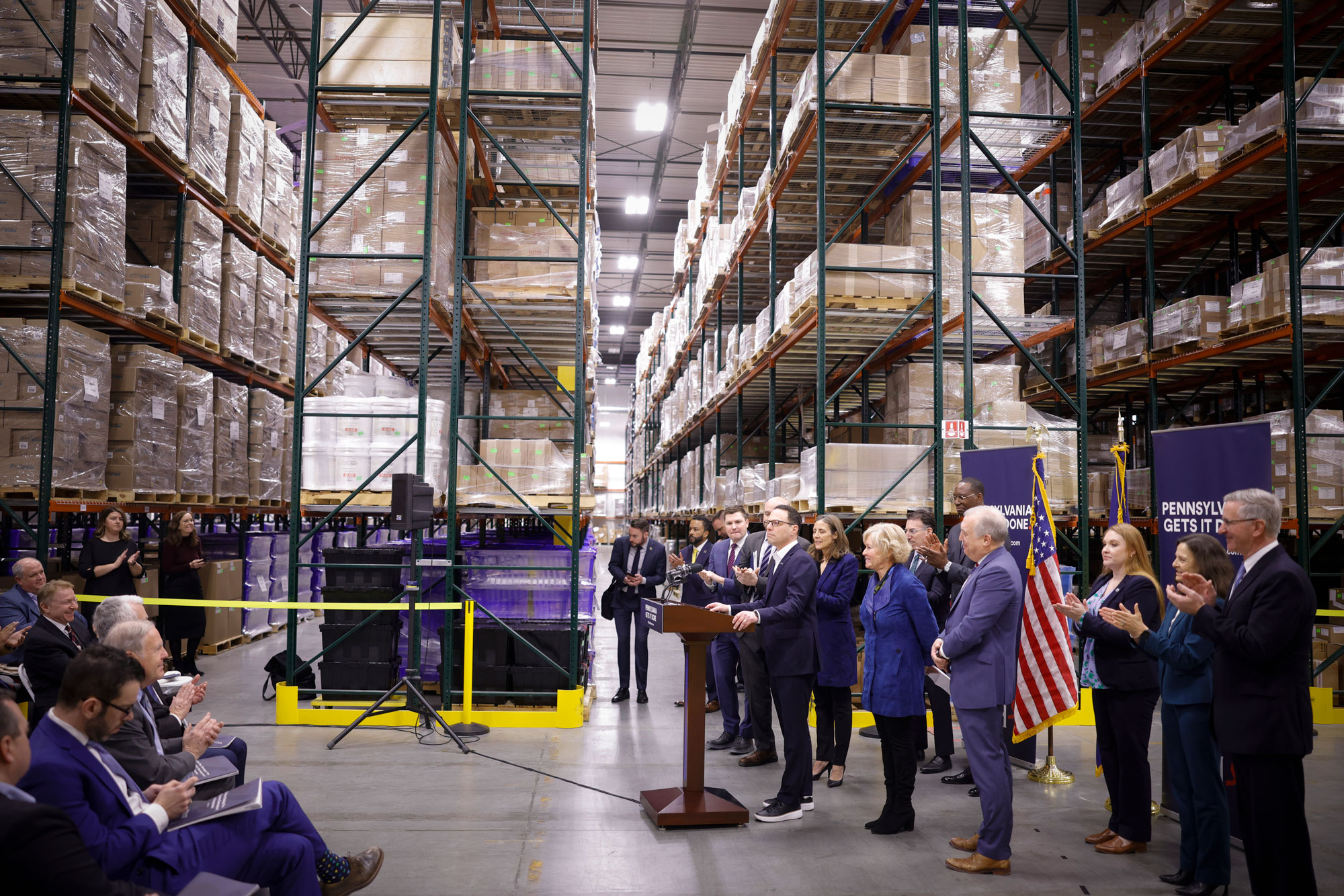Policy
Future tense: The Shapiro administration tries to plan the state economy over the next decade
How the administration’s new economic development strategy can impact the state’s outlook depends on who’s doing the talking.

Gov. Josh Shapiro has made improving the state’s economic climate a chief priority of his first term. Commonwealth Media Services
In what has now become one of his go-to taglines, Gov. Josh Shapiro, standing in a crowded Pennsylvania Capitol rotunda for his second budget address in February, declared that he was “sick and tired of losing to friggin’ Ohio!”
The line has become shorthand for Shapiro’s oft-stated contention that Pennsylvania’s neighbor to the west has been putting more money into economic development initiatives than the commonwealth – and is reaping the rewards.
“Ohio has one-and-a-half million fewer people than Pennsylvania, yet they’ve invested over seven times more in economic development than we have. And you know what? Their investment is paying off,” the governor said.
The Buckeye State has, for its part, invested money into job creation and other economic development initiatives. Take the JobsOhio program, for instance, which uses profits from the sale of liquor in the state to promote efforts that attract, retain and expand businesses and job opportunities in Ohio through investments, grants and other means.
A review of the program’s work found that direct capital investment by companies working with JobsOhio supported 25,012 jobs, $1.62 billion in labor income, $1.76 billion in gross state product and $3.3 billion in economic output each year in the state’s construction industry between 2011 and 2021.

New and expanded business operations created through JobsOhio investments resulted in a cumulative 1,398,822 job years with an associated labor income of $83.64 billion, while also contributing $154.33 billion in gross state product, according to an analysis of the program’s economic impacts.
Shapiro and his administration believe it’s time to bring a similar type of mindset – and set of investments – to the commonwealth.
In January, days before unveiling his second executive budget proposal, Shapiro released something his administration said was long overdue: a 10-year economic development strategy for the entire commonwealth.
The plan, which is more than 50 pages long, focuses on several key goals: investing in economic growth; expanding career opportunities; fostering innovation; and making government work “at the speed of business” – the last of which has been a common refrain from Shapiro.
The plan also identifies five sectors of Pennsylvania industry that should be targeted for investment and growth: agriculture; energy; life sciences; manufacturing; and robotics and technology. “Focusing on these sectors will enable us to build out industry clusters in high-growth, high-value industry segments, and to double down in industries of historic and economic significance to Pennsylvania,” the plan reads.
The administration unveiled the plan in January in the state’s Lehigh Valley region, an area once known for being the home to manufacturing heavyweights like Bethlehem Steel. Since the fall of Bethlehem Steel and other manufacturers, the region has embraced new forms of manufacturing, like medical devices, and over the last several decades, leaders at the local level have worked together to craft an economic vision for the area to ensure it didn’t get left behind by the evolving economy.
George Lewis, a special assistant to the president of the Lehigh Valley Economic Development Corporation, told City & State that the LVEDC was founded in the 1990s by businesses and community leaders to respond to the changing economy and job losses impacting the region.

“This organization was formed around that time in the mid-1990s by a group of the larger employers in the region. They came together and realized, ‘If we don’t do something to change the trajectory, we’re going to end up like a lot of the classic Rust Belt stories of lost jobs, brain drain and losing your young people to other areas for other opportunities.’” Lewis said. “We needed to create a way to provide job opportunities, keep people here, keep the economy growing – and do it on the basis of things that we knew how to do.”
Thus, the LVEDC was born; since then, the organization has been focused on marketing the Lehigh Valley as a unique region across municipal boundaries, developing a strategic economic plan for the area and attracting businesses and new opportunities.
Lewis said the region has continued to rely on manufacturing as it continues to transition away from steel and toward medical devices, food and beverage products, plastics and electronics, to name a few.
It’s that type of planning and follow-through that the Shapiro administration wants to bring to a statewide scale.
“When we launched this plan, we did so in the Lehigh Valley very purposefully, because the Lehigh Valley has a lot going for it … because of a deliberate, multiyear effort of partnering by business and others in that region to help it grow and succeed,” said Rick Siger, the secretary of the Pennsylvania Department of Community and Economic Development.
Siger has joined Shapiro at events across the state to promote the economic development strategy, and he walked through some of the details in an interview with City & State.
In total, the plan has 19 strategic economic development initiatives; the ideas range from more funding for site readiness and tourism efforts, to establishing entrepreneurial startup competitions and starting a Buy Pennsylvania Initiative to reinforce in-state supply chains.
Not all of the initiatives would require buy-in from state lawmakers: The Shapiro administration has already taken steps to make reforms to the state’s permitting processes. In January 2023, Shapiro signed an executive order establishing response times and a money-back guarantee for permit application fees.
Other parts of the plan that would require more significant amounts of funding would require legislative approval. “There’s no question that a bunch of things in here require either policy change or funding,” Siger said. “That is why, in some sense, it was so important to do a plan in such an open and collaborative way, because it is going to take all of us together, not just state government, legislative branch, executive branch, but economic developers, and business, and labor and universities all across Pennsylvania getting behind this plan, putting a shoulder to the wheel to move it ahead.”
Siger said an expansion of the Pennsylvania Strategic Investments to Enhance Sites Program, or PA SITES, a program that provides grants to develop sites for businesses to locate, could prove particularly beneficial to Pennsylvania by making the state more enticing for businesses to locate.
“Having these sites ready gives us a huge leg up in speed to market. Many states have similar programs and they’ve had success with it,” Siger said. “We believe that a program like this can help us really get a leg up in helping companies achieve that speed, and therefore make Pennsylvania much more competitive.”
The program has been well received in other parts of the state, including western Pennsylvania.
Matt Smith, the chief growth officer at the Allegheny Conference on Community Development, celebrated the investments that the PA SITES program has made already through discretionary funds divvied out by the administration at a May press conference announcing a $2.5 million grant awarded to Adam Eidemiller, Inc, which will be remediating and developing a site in Westmoreland County.
In his most recent budget proposal, Shapiro is seeking an additional $500 million to expand the program this year.
“It’s so critical that we have the $500 million site development fund in place for us to tap into and use as a resource,” Smith said. “The reason why that matters is we’re out there fighting every day for economic development investment for this region. We went back and looked over the last 20 years – the No. 1 reason we lost projects, and probably many that we weren’t even in the hunt to go out and win, was because of the lack of sites, the lack of real estate, the lack of pad-ready sites that the governor talked about.”
Shapiro said in May that interest in the initial $10 million in PA SITES funding far outpaced the available funds, reinforcing the need for the $500 million outlined in his budget.
“I told you before that we launched a pilot program of $10 million. Well, we got $235 million in quality applications for 10 million bucks. It shows that there is a real demand – a serious demand – for these sites,” he said. “There is a real need here, and it’s time for us to fill that gap.”
Lewis told City & State that he was pleased not only to see a statewide economic development strategy take shape, but to see the administration choose the Lehigh Valley to announce it.
“We feel like we now have somebody in our corner. We know what’s going on here at the local level, but to have that state level of support is important,” he said. He added that he hopes both Shapiro’s plan and the Lehigh Valley can serve as a model for other regions to attract new businesses and new opportunities to the commonwealth.
“We’re showing that we can get it done in Pennsylvania, that with the right resources and the right selling points, you can go toe-to-toe with the Sun Belt states – with Texas and Florida and Georgia – and compete for projects, and get companies to come to your area, to expand in your area,” he said. “We’re doing it here, and hopefully it’s a model, as the governor is saying, that other regions in Pennsylvania can use to compete and win projects in their areas, too.”
